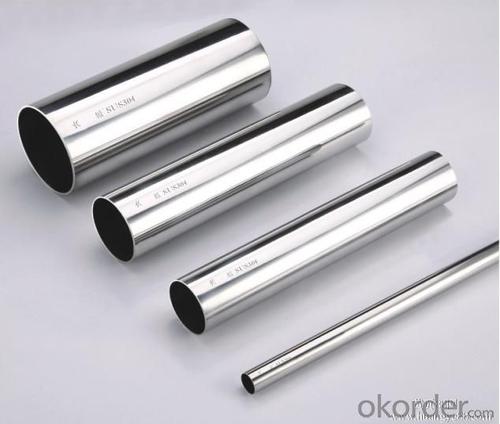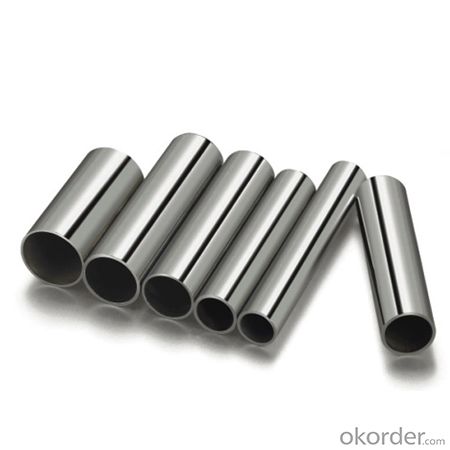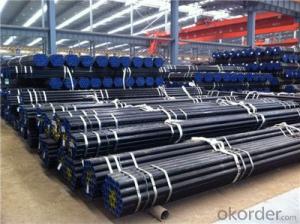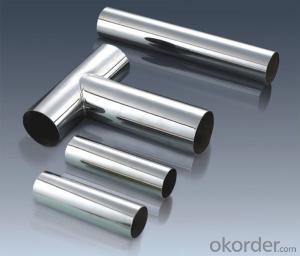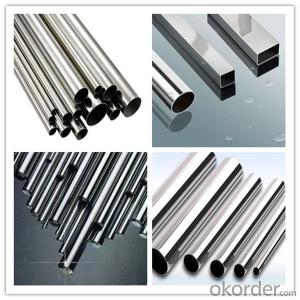304 Stainless Steel Pipe Clamp with low price
- Loading Port:
- Tianjin
- Payment Terms:
- TT OR LC
- Min Order Qty:
- 35 m.t
- Supply Capability:
- 5000 m.t/month
OKorder Service Pledge
OKorder Financial Service
You Might Also Like
Specification
Structure :
Seamless pipe is formed by drawing a solid billet over a piercing rod to create the hollow shell. As the manufacturing process does not include any welding, seamless pipes are perceived to be stronger and more reliable. Historically seamless pipe was regarded as withstanding pressure better than other types, and was often more easily available than welded pipe.
Main Features :
• High manufacturing accuracy
• High strength
• Small inertia resistance
• Strong heat dissipation ability
• Good visual effect
• Reasonable price
FAQ :
A. How is the quality of your products?
Our products are manufactured strictly according to national and internaional standard, and we take a test on every pipe before delivered out. If you want see our quality certifications and all kinds of testing report, please just ask us for it.
Guaranteed: If products’ quality don’t accord to discription as we give or the promise before you place order, we promise 100% refund.
B. How about price?
Yes, we are factory and be able to give you lowest price below market one, and we have a policy that “ for saving time and absolutely honest business attitude, we quote as lowest as possible for any customer, and discount can be given according to quantity”,if you like bargain and factory price is not low enough as you think, just don’t waste your time.Please trust the quotation we would give you, it is professional one.
C.Why should you chose us?
Chose happens because of quality, then price, We can give you both.Additionally, we can also offer professional products inquiry, products knowledge train(for agents), smooth goods delivery, exellent customer solution proposals.Our service formula: good quality+good price+good service=customer’s trust
SGS test is available, customer inspection before shipping is welcome, third party inspection is no problem.
Any question, pls feel free to contact us !
Product image:
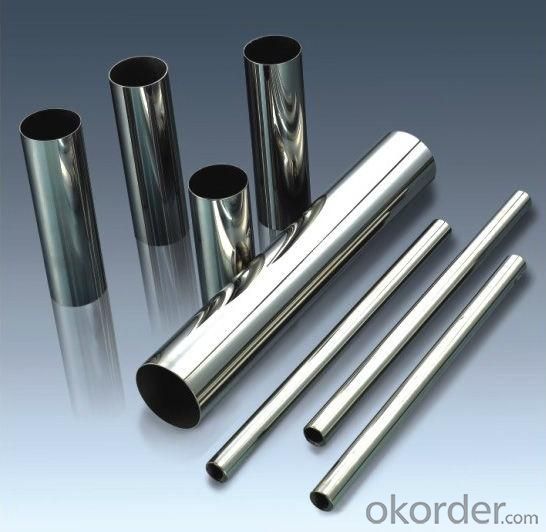

Company Information:
CNBM International Corporation (CNBM International) is the most important trading platform of CNBM Group Corporation, a state-owned company under the direct supervision of State-owned Assets Supervision and Administration Commission of the State Council.
Since 2004, the trading volume of CNBM International has been doubled in 5 successive years owing to the support of superior corporations and effort of all staff. Meanwhile, we have established strategic partnerships with hundreds of domestic manufacturers and sound business relations with clients from over 120 countries. Currently, we have wholly-owned overseas subsidiaries and branches in 5 countries with a view to realize localization, which also represents an essential progress in our globalization target.
- Q: Can stainless steel pipes be used for cryogenic applications?
- Cryogenic applications can indeed utilize stainless steel pipes. Stainless steel is widely recognized for its exceptional properties at low temperatures, including admirable strength, flexibility, and resistance against corrosion. These qualities render stainless steel pipes suitable for the transportation and storage of cryogenic fluids, like liquid nitrogen, oxygen, or argon. The high strength-to-weight ratio of stainless steel permits the construction of lightweight and durable cryogenic systems. Furthermore, stainless steel pipes can endure the extreme temperature gradients and thermal stresses commonly encountered in cryogenic applications. Nevertheless, it is crucial to select the appropriate grade of stainless steel specifically engineered for cryogenic service to ensure optimal performance and safety.
- Q: What is the difference between 304N and 304LN stainless steel pipes?
- The main difference between 304N and 304LN stainless steel pipes lies in their chemical composition. 304N stainless steel contains a higher nitrogen content, which improves its strength and corrosion resistance compared to 304LN stainless steel. This makes 304N more suitable for applications that require higher tensile strength and resistance to pitting and crevice corrosion. 304LN stainless steel, on the other hand, has a lower nitrogen content and is typically used in applications where lower strength and corrosion resistance are acceptable.
- Q: What are the different types of stainless steel pipes available?
- There are several different types of stainless steel pipes available, including seamless pipes, welded pipes, and duplex pipes. Additionally, stainless steel pipes can be classified based on their grade or composition, such as austenitic, ferritic, or martensitic stainless steel pipes. Each type of stainless steel pipe has its own unique properties and applications.
- Q: Are stainless steel pipes suitable for semiconductor industries?
- Stainless steel pipes are ideal for use in semiconductor industries. They possess excellent qualities that make them widely used in various sectors, including semiconductor manufacturing. The primary reason why stainless steel pipes are suitable for the semiconductor industry is their remarkable resistance to corrosion. Given that the semiconductor manufacturing process involves the usage of corrosive chemicals and gases, stainless steel pipes can endure the harsh conditions and remain intact for extended periods. Moreover, stainless steel pipes exhibit exceptional mechanical properties, such as high strength and durability. These attributes are crucial in semiconductor industries where the pipes must withstand both high pressure and temperature conditions. Stainless steel pipes can endure these demanding circumstances without warping or breaking, ensuring the safety and efficiency of the semiconductor manufacturing process. Additionally, stainless steel pipes possess excellent cleanliness and hygienic properties, making them highly favored in semiconductor industries. Maintaining cleanliness is of utmost importance in these sectors to prevent contamination. Stainless steel pipes have a smooth surface that prevents the accumulation of particles, making them easy to clean and sterilize. Lastly, stainless steel pipes possess excellent thermal conductivity, which is vital in semiconductor industries that require precise temperature control. These pipes efficiently transfer heat, ensuring stable and accurate temperature regulation during various manufacturing processes. To summarize, stainless steel pipes are highly suitable for semiconductor industries due to their resistance to corrosion, mechanical properties, cleanliness, and thermal conductivity. They offer dependable and efficient performance, making them the preferred choice for the demanding requirements of semiconductor manufacturing.
- Q: What is the difference between 347 and 347H stainless steel pipes?
- The carbon content is the main distinguishing factor between 347 and 347H stainless steel pipes. In the case of 347 pipes, the maximum carbon content is 0.08%, while 347H pipes have a higher carbon content range of 0.04-0.10%. This increased carbon content in 347H pipes contributes to enhanced strength at high temperatures and greater resistance to sensitization, which is the formation of chromium carbides at grain boundaries that can lead to intergranular corrosion. Because of its higher carbon content, it is generally recommended to use 347H stainless steel pipes for applications involving elevated temperatures and thermal cycling. These pipes exhibit improved resistance to creep and can withstand higher levels of stress compared to 347 stainless steel pipes. Industries such as chemical processing, petrochemical, and power generation commonly employ 347H pipes due to their exposure to high temperatures and corrosive environments. To summarize, the disparity between 347 and 347H stainless steel pipes rests in their carbon content. 347H pipes offer superior strength at high temperatures and resistance to sensitization. The choice between the two depends on the specific requirements and conditions of the application.
- Q: What is the difference between 304J2 and 316J2 stainless steel pipes?
- The main difference between 304J2 and 316J2 stainless steel pipes lies in their chemical composition. While both alloys contain the base elements iron and carbon, 304J2 stainless steel pipes have a higher concentration of chromium and nickel, while 316J2 stainless steel pipes have a higher concentration of chromium, nickel, and molybdenum. This makes 316J2 stainless steel pipes more resistant to corrosion, especially in environments with chloride ions, such as saltwater or marine applications. Additionally, 316J2 stainless steel pipes have better heat resistance and are more suitable for high-temperature applications.
- Q: What's the difference between stainless steel decorative pipes and polished stainless steel pipes?
- Stainless steel decorative tubes are mainly used for decoration, such as railings, staircases, hand guards, railings, windows and so on, the wall thickness is very thin,Polished stainless steel pipe is not the same, the industry can also be used, that is, just made out, some rough, not smooth, so polished under the smooth, according to customer needs.
- Q: What is the difference between 304J5 and 316J5 stainless steel pipes?
- The main difference between 304J5 and 316J5 stainless steel pipes lies in their composition. While both are stainless steels, 304J5 contains a higher percentage of chromium and nickel, making it more corrosion resistant than 316J5. On the other hand, 316J5 contains a small amount of molybdenum, which enhances its resistance to pitting and crevice corrosion. Therefore, if corrosion resistance is of utmost importance, 304J5 would be the preferred choice, whereas if added resistance against pitting and crevice corrosion is desired, 316J5 would be the better option.
- Q: What is the difference between 201 and 316 stainless steel pipes?
- The main difference between 201 and 316 stainless steel pipes lies in their composition and properties. While both are corrosion-resistant, 316 stainless steel has higher corrosion resistance due to the presence of molybdenum. Additionally, 316 stainless steel is more durable and has better strength and heat resistance compared to 201 stainless steel, which makes it suitable for more demanding applications such as marine environments and chemical processing industries.
- Q: What kind of welding machine is used for welding thin stainless steel plate and stainless steel square tube?
- 1 mm thick enough, basically argon arc welding machine can, 0.2 thick stainless steel plate welding is not good ah, how have three or four points it can be positive or negative, only a few joints only, mainly to see the technology myself you, not what, the polishing wheel is on the line let's do it, you can buy a good quality of argon arc welding machine, the high price of the arc is stable
Send your message to us
304 Stainless Steel Pipe Clamp with low price
- Loading Port:
- Tianjin
- Payment Terms:
- TT OR LC
- Min Order Qty:
- 35 m.t
- Supply Capability:
- 5000 m.t/month
OKorder Service Pledge
OKorder Financial Service
Similar products
Hot products
Hot Searches
Related keywords


